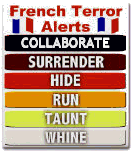By Megan Levy and agencies21/10/2007The US Air Force has disciplined 70 airmen after a B-52 bomber armed with nuclear missiles was mistakenly flown across the US.
The bomber flew the next morning to Louisiana, where it sat on a tarmac for hours before anyone noticed the nuclear warheads.The missiles were supposed to have been taken to Louisiana but the warheads should have been removed beforehand.
The crew flying the plane was unaware nuclear warheads were on its wing.The incident was so serious that President George W. Bush and Defence Secretary Robert Gates were informed immediately.Among those disciplined were four officers who were relieved of their commands following an investigation that found widespread disregard for the rules on handling weapons.
Announcing the results of the six-week probe into the incident, Maj. Gen. Richard Newton, the Air Force deputy chief of staff for operations, said the flight resulted from an "unprecedented string of procedural errors."The errors began with a failure by airmen to conduct a required inspection of the missiles before they were loaded aboard the B-52 bomber at Minot, he said.advertisement"There has been an erosion of adherence to weapons-handling standards at Minot Air Force Base and Barksdale Air Force Base," he said.
Among the officers who were relieved of their commands this week was the 5th Bomb Wing commander at Minot, while some 65 airmen have been decertified from handling nuclear weapons.The certification process looks at a person's psychological profile, any medications they are taking and other factors in determining a person's reliability to handle weapons.An official said that security was increased as soon as the nuclear warheads were discovered.
The Air Combat Command ordered a command-wide stand-down to set aside time for personnel to review procedures, officials said.Air Force Secretary Michael W. Wynne said it was an unacceptable mistake and a "clear deviation from our exacting standards".







